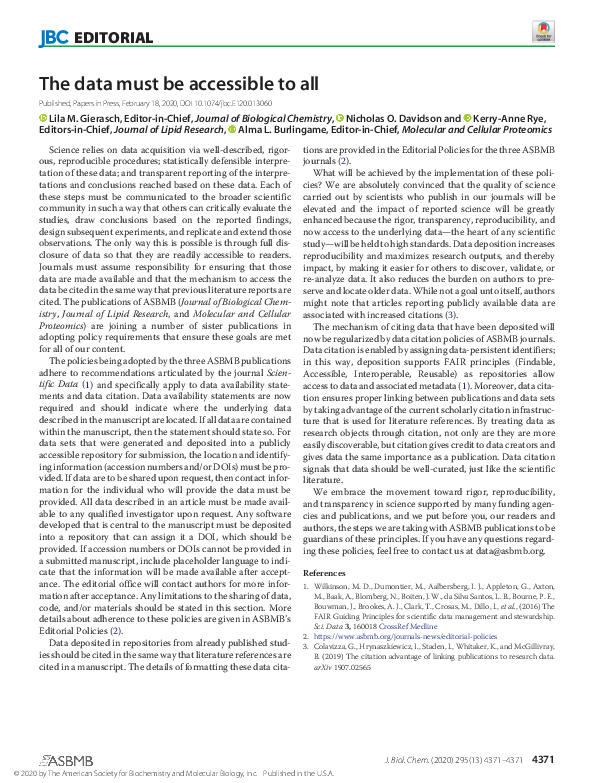Academia.edu no longer supports Internet Explorer.
To browse Academia.edu and the wider internet faster and more securely, please take a few seconds to upgrade your browser.
The data must be accessible to all
Related Papers
2004 •
2006 •
2020 •
Preparation of Guidelines for the formulation of scientific publishing policies of citing research data in scientific publications and for providing access to primary data on which scientific discussions are based is one of the goals of the Research Data Alliance (RDA) Node Slovenia. The Guidelines are intended for scientific publishers and editors of scientific journals to assist them in policy-making of the so-called open access to research data requirements as a starting point for the preparation of any journal-adapted guidance for authors, reviewers and editors. They are accompanied by an example of detailed instructions for authors, to which editorial boards may refer to authors when preparing their instructions and, where appropriate, direct authors to extract from their guidelines independent Explanations for understanding the policies of scientific publishers in providing access to primary data used in articles. We thank the Working Group of the RDA Node Slovenia and all par...
Contemporary clinical trials
NIH/NCATS/GRDR® Common Data Elements: A leading force for standardized data collection2015 •
The main goal of the NIH/NCATS GRDR® program is to serve as a central web-based global data repository to integrate de-identified patient clinical data from rare disease registries, EHR, clinical data and other data sources, in a standardized manner, to be available to researchers for conducting various biomedical studies, including clinical trials and to support analyses within and across diseases. The aim of the program is to advance research for many rare diseases and, by extension, common diseases as well. One of the first tasks toward achieving this goal was the development of a set of Common Data Elements (CDEs), which are controlled terminologies that represent collected data. The use of CDEs facilitates the integration of patient information. The GRDR CDEs have been the cornerstone of the GRDR repository, as well as of several other national and international patient registries. As a result many new opportunities for collaboration and networking are now available and being p...
2005 •
Toxicological Sciences
Toward a Checklist for Exchange and Interpretation of Data from a Toxicology Study2007 •
2021 •
Operation of Online Open access journals and organizing scientific and business events. Our Vision The Main Vision of OMICS Group is to make Healthcare and Scientific Information Open Access T his article was originally published in a journal by Open Access Scientific Reports, and the attached copy is provided by Open Access Scientific Reports for the author's benefit and for the benefit of the author's institution, for commercial/research/educational use including without limitation use in instruction at your institution, sending it to specific colleagues that you know, and providing a copy to your institution's administrator. All other uses, reproduction and distribution, including without limitation commercial reprints, selling or licensing copies or access, or posting on open internet sites, your personal or institution's website or repository, are requested to cite properly. MicroRNA Liposome Liposomes are lipids that interact together and make a vesicular struc...
2014 •
RELATED PAPERS
CAR-T THERAPY FOR LONG-LASTING HIV TREATMENT (Atena Editora)
CAR-T THERAPY FOR LONG-LASTING HIV TREATMENT (Atena Editora)2024 •
2022 •
Publishing Research Quarterly
“With a little help from my friends”: Training and education of professional booksellers and publishers in the Netherlands1993 •
Eikasía Revista de Filosofía
Eliminación De La Subjetividad De Los FinesISPRS Journal of Photogrammetry and Remote Sensing
Mapping invasive species and spectral mixture relationships with neotropical woody formations in southeastern Brazil2015 •
Social Inclusion 2024 • Volume 12 • Article 7597 (This article is part of the issue “Who Wants To Share? Attitudes Towards Horizontal Redistribution Across the Globe” edited by Frances Stewart (University of Oxford), Arnim Langer (KU Leuven), and Line Kuppens (University of Amsterdam), fully open...
Contextualized Rights as Effective Rights to All: The Case of Affirmative Action in Brazil2024 •
Professional Book Research in Organizations and Management Publishing, Bradford Special Issue, 2022.
Beyond the Buzz: Real-World Success with Artificial Intelligence and Virtual Reality in Digital Marketing.
 Nicholas Davidson
Nicholas Davidson